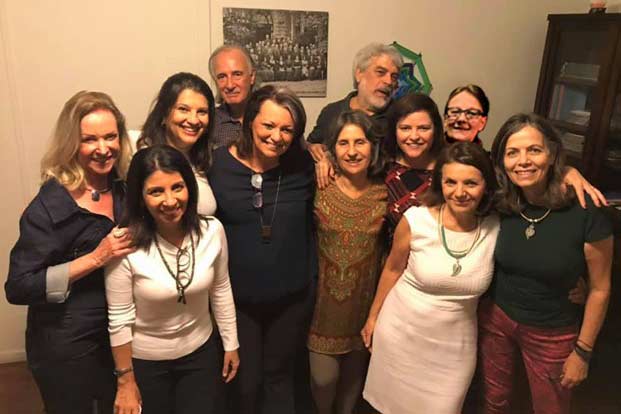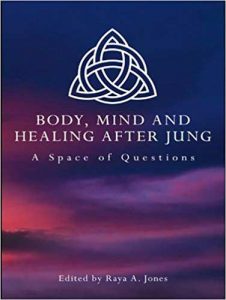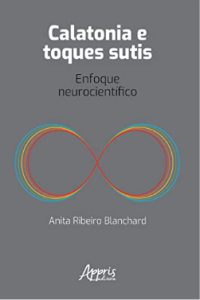Calatonia International Training
The CIT is a project developed by a group of alumni from the Instituto Sedes Sapientiae, where Pethö Sándor taught his method. Having studied with Sándor for many years, in several of his courses, this group aligns itself with the purpose of promoting his work within the standards in which he structured it. We belong to a larger community of professionals who have adopted his method, a community gathered at the Calatonia.Org.
We invite you to join us for some exciting training!

Calatonia & Subtle Touch Training
Expand your somatic therapy repertoire and enhance your professional skills by learning new somatic techniques that facilitate well-being and gradually decrease your patient’s symptomatology. At the same time, these techniques take patients safely into contemplative states. These mental states allow nonjudgmental observation of sensations, thoughts, images, and emotions that are difficult to access through verbal therapy alone.
Who can attend?
Psychotherapists, psychologists, nurses, psychiatrists, health and education professionals, child development workers, psychomotor practitioners, speech and occupational therapists, physiotherapists, certified body workers, massage therapists, coaches, and health practitioners and pre-licensed students, who may benefit from integrating structured touch protocols into their practice, to heal trauma and attachment, and to enhance their patients’ global functioning.
If you are new to mind-body integration, or feel ambivalent about integrating touch into your practice, attending training for personal and professional growth may be the best step to ascertain its validity, depth and usefulness as a tool for your practice.
Calatonia
Calatonia & Subtle Touch
“…the skin is a site of the events and processes crucial to the way we think about, feel about, and interact with one another…” – McGlone, Wessberg, & Olausson (2014)
The Calatonia method has been used in psychotherapy for over fifty years with both children and adults, in trauma work, rehabilitation, education, speech therapy, and many other areas. In the last twenty years, as the cognitive neuroscience and neuropsychology of touch evolved, Sándor’s work has received endorsement not only from its five decades of clinical application but also from viable hypotheses on the neural connectivity it activates, introduced briefly in the book, Calatonia: A therapeutic approach that promotes soma-psyche regulation and discussed at length in the new book (Portuguese), Calatonia e Toques Sutis: Enfoque Neuroscientifico (Calatonia and Subtle Touches: a neuroscientific review). Calatonia is usually experienced as a state of profound contemplation and relaxation that takes a person from distress to well-being, and with regular repetitions, to a stable state of optimal balance of emotions, thoughts and behaviours.
Pethö Sándor & a Brief History of Calatonia
Calatonia arose out of necessity during WWII, and it was probably the first somatic therapy developed from, and initially for, those suffering from war trauma. After the war, Calatonia became a psychotherapy method. Sándor’s method was ahead of its time in relation to the recent findings from interpersonal neurobiology and social-affective neuroscience as even back in the 1950s, it proposed that patients could experience regulated states in dyadic regulation with the therapist, within a safe, empathic and attuned relationship. Sándor noticed that with regular applications of Calatonia, its positive effects became cumulative and stable, and consequently the traumatic impact slowly weakened. By strengthening new neural connectivity linked to well-being and to interpersonal regulation, Calatonia helped to reinstate trust in others and self, and allowed patients of the post-war to lead more adaptive lives after trauma.
Beyond Trauma: Calatonia in Healing, Development and Self-Actualisation
Calatonia was created during World War II as an effective trauma therapy; however, it later became widely used in the practice of psychotherapy and other healing arts.
Many patients come for psychotherapy because they are experiencing social disconnection, political and financial uncertainty, stress and anxiety, or they are unhappy about the impermanence of their relationships, the outcome of a particular life-event, or because they are facing a crisis of meaning and purpose. Moreover, our fast-paced, technologically-saturated societies sometimes generate a major physical alienation from oneself and others – from our physical, instinctual nature. However, these patients don’t necessarily present behaviours that would suggest any specific mental health problems.
Thus, some patients come to therapy in search of connectedness, to learn about themselves, to integrate forgotten aspects or to uncover new aspects of their lives, and to build a meaningful life-narrative that makes sense of their experiences, their past and their future. In these cases, Calatonia and Subtle Touch may provide a gentle and profound therapeutic path for self-knowledge.
USA
SUBTLE TOUCH LEVEL II
The 2-day intermediate training presents several Subtle Touch techniques that rely on the affective-affiliative touch system, known as C-tactile. It focusses on reorganising the patient’s emotional and behavioural patterns, from an experiential basis, in dyadic support with the therapist.
Click on a date to read more about this module:
2024
SUBTLE TOUCH LEVEL III
The 2-day training revises the previous two modules and introduces sequences of touches on the spine, passive movements of small and large joints, among other techniques.
Click on a date to read more about this module:
Date to be announced in 2024
SUBTLE TOUCH TRAINING FOR CHILD PSYCHOTHERAPY
This 2½-day training offers hands-on experience in learning, applying, and receiving somatic techniques to use individually with child patient. The theoretical part includes the developmental basis of this practice, its application and the ethos of working with children.
Click on a date to read more about this module:
Date to be announced in 2024
EUROPE
CALATONIA® O TOQUE DA PAZ INTERIOR
Junho 21 – Junho 23, 2024
Centro Holístico do Porto – CHDP
Porto – Portugal
This training will be held in Portuguese
Formação oferecida em Português
“Há uma distância extraordinária da cabeça ao coração, uma distância de dez, vinte, trinta anos ou uma vida inteira” (Carl Jung)
Essa distância só pode ser percorrida experimentando a verdade do coração, e o caminho mais curto para o coração é percorrido através do toque que cuida.
Usando uma sequência de toques sutis, a Calatonia promove uma experiência terapêutica que cria a atmosfera certa para a contemplação interior, conhecimento de si e dos outros, bem como sentimentos de bem-estar e paz. Você experimentará a integração de muitos aspectos da vida: corpo, emoções, pensamentos, sonhos, símbolos e alma, e aprenderá como fazer o mesmo pelos outros.
Esta formação introdutória de 2 ½ dias oferece experiência prática em aprender, aplicar e receber a Calatonia e as informações sobre a base teórica deste método. Esta formação corresponde ao nível básico Calatonia I, habilitando o participante a praticar a técnica.
Books
Testimonials
Calatonia is a gentle work, but very deep. The workshop I took to learn the technique validated my intentions of utilising it with my clients, as a psychotherapist. I felt confident that it could do something substantial for my clients, as it did for me. During the five-day training at Esalen, I went through a restructuring of my way of seeing and being in the world, which was substantiated in a series of dreams.
Priscila Diotto, Psychotherapist, Miami, US
I find Calatonia a very helpful medium to promote a safe sense of self. People affected by early developmental trauma have not been able to develop a safe sense of self and have no experience of feeling safe when surrendering to the caring touch of another person. The non-intrusive nature of Calatonia helps to achieve this: to feel safe in one’s own body and to surrender to that safety, thus promoting self-trust, as well as trust in the therapeutic relationship.
Marianne Henderson, Psychotherapist, Suffolk, UK
Anita offered our therapeutic team two Calatonia training workshops, each bespoke to the needs of our specialist psychological treatment service. The first involved teaching us the principles of Calatonia and the basic sequence and application of Calatonia. This enabled our team of psychotherapists and clinical psychologists to incorporate Calatonia into their therapeutic work with clients, which specialises in trauma healing. The second workshop two years later was more advanced. Anita helped deepen our understanding of the neurophysiological processes underlying Calatonia and taught us the practical application of more advanced subtle touch healing techniques, which we practised on each other. This further enhanced our team’s confidence in incorporating both Calatonia and Subtle Work into their psychotherapeutic work.
Claudia Herbert, Clinical Psychologist, Witney, UK
A very worthwhile and useful workshop, professionally and personally, a wonderful approach that has many applications. It had a real impact on me and was very thought provoking in terms on my own practice and how I can develop that. Learnt a lot from Anita and it has left me with many ideas for the future. Many thanks.
Ben Clayton-Jolly, Psychological Coach, Austria
Calatonia is a deep and healing modality. Anita is skilled in her teaching making it so easy to learn this subtle method and understand both the scientific background and the intuitive healing involved.
Philippa Vick, Psychotherapist, Bath, UK
I learned about Calatonia in 2002 and took a course in 2003 with Joyce Bittencourt, a former student of Sándor, who taught Calatonia in El Cerrito, California. It was there that I had my first contact and I began to read about this technique, without realizing how Calatonia would become the most necessary “subtle touch” in my husband’s (and my) life, individually and as a couple, many years later.
My husband was diagnosed with Parkinson’s disease in 2012. Since his diagnosis, we have researched in depth about available treatments and complementary therapies. One day, not knowing what else to do, in one of those moments when words or any other therapy could not help my husband feel better, Calatonia came to mind. I thought about it because of its subtle and non-invasive nature and decided to take a refresher training when the opportunity presented in 2016 to use it with my husband.
Since then, Calatonia has worked as a therapeutic tool for my husband’s condition. For him, it offers an opportunity to “go within” away from stresses or anxieties, or the pressure to learn a new modality of treatment. For me, it offers an invitation for inner contemplation – together.
Maria Eugenia Potkin, BA, Calatonia Practitioner, Malibu, US




